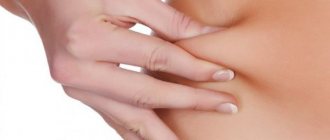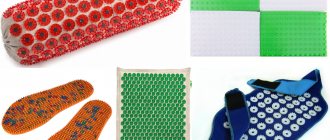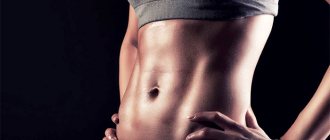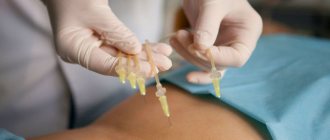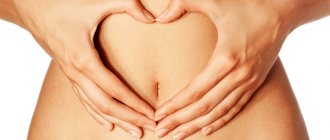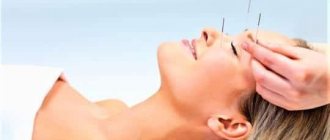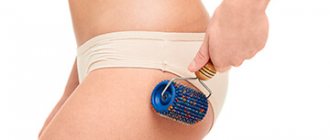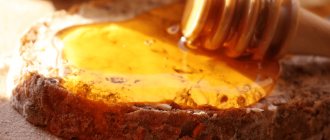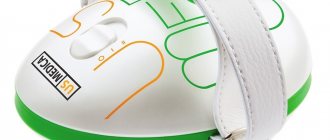Is self-massage of the thighs effective for weight loss?
Self-massage is a method of prevention and treatment using techniques of mechanical influence on the tissues of various parts of the human body, performed by hand or with special devices. Self-massage for weight loss differs from regular massage in that it is performed with one’s own hand, which somewhat limits the areas of the body available for the procedure. In everything else: massage techniques, forms and types, effectiveness on the body - the sessions are identical.
Benefits for the body
A massage session has a complex and diverse effect on the body. Massage of the legs and buttocks restores the functioning of blood vessels, accelerates metabolic processes, which promotes weight loss and eliminates skin deformation. With each session you see a reduction in volume and cellulite in the thighs. Massage can relax or energize, has a beneficial effect on the skin, subcutaneous fat layer, muscles, joints, cardiovascular and central nervous systems:
- keratinized scales of the epidermis are removed;
- tone increases, skin tightens;
- blood circulation is activated;
- the functioning of the sebaceous and sweat glands improves;
- the skin is saturated with oxygen;
- the elasticity of muscle fibers increases;
- pain after exercise is eliminated;
- the conductivity of nerve endings improves.
Techniques
To carry out self-massage for weight loss, you need to familiarize yourself with the basic techniques of the procedure: stroking, squeezing, kneading, shaking, shaking, percussive techniques, rubbing and passive movements. Performing a weighted move means placing one hand on top of the other. All techniques are used when targeting the thigh area for weight loss.
- Stroking is an important, albeit simple technique to perform. During stroking, the skin is prepared for massage at the beginning of the session and calms down after the procedure. Press your palm firmly onto the area being massaged, grasping it lightly. The palm slide should be slow and rhythmic.
- Squeezing - during this technique, the effect is on the deeper layers of the muscles. In the process, the nervous system is toned, swelling and congestion are eliminated, and muscle condition improves. Pressure on the body is exerted by the pads of the fingers or the edge of the palm. You need to complete the squeezing with several strokes.
- Rubbing – accelerates blood circulation, helps resolve swelling and fluid accumulations.
- Kneading is the main technique of self-massage, thanks to which the deep-lying muscles are massaged. There are five types of kneading used for self-massage of the thighs for weight loss:
- ordinary - grab the muscle tightly with straight fingers, squeeze, and with rotational movements slide along the muscle, capturing new areas;
- double bar – perform in the same way as a regular bar, but with weights;
- double ring - grab the muscle crosswise with both hands at the distance of the hand and pull simultaneously with each hand in different directions, move along the muscle;
- longitudinal - place one hand in front of the other, knead, gradually moving your hands forward;
- kneading with fingertips - position your fingers so that they penetrate deeper into the muscles.
- Shaking – affects superficial and deep-lying tissues. Shaking is great for relaxing your muscles. Perform this technique by shaking the muscle being massaged with your thumb and little finger.
- Shaking - the effect on the body is similar to the previous technique, but differs in the technique of execution. Shift your weight to one leg, place the other on your toes, and shake so that the muscles on your thigh shake.
- Impact techniques – promote blood flow, increase the contractile force of muscle fibers, and have a stimulating effect. Impact techniques include:
- tapping - bend your fingers into a fist, continuously apply quick, painless blows with the edge of your hand;
- clapping - clap alternately with relaxed palms;
- chopping - do it with the edge of your palm with relaxed fingers.
Causes of cellulite
The fundamental factor in the development of cellulite is an imbalance of metabolic processes, which leads to improper deposition of subcutaneous adipose tissue.

Adipocytes (fat cells) accumulate fat unevenly and increase in size so that the collagen fibers delimiting the connective tissue begin to compress them - a dense fat “lobule” is formed which rises to the surface, forming a characteristic skin relief.
In addition, prolonged compression leads to disruption of blood and lymph circulation, and this is fraught with swelling. If at the initial stage cellulite is more of a cosmetic problem, then as it progresses, a person may even experience pain - the nerve endings located in the area of the body affected by cellulite are pinched, and pain occurs.
Predisposing factors are:
- Hormonal imbalance;
- Vascular diseases;
- Excessive weight;
- Lack of physical activity;
- Addiction to alcohol and smoking;
- Stress, lack of sleep;
- Unbalanced diet;
- Frequent weight fluctuations (sharp weight gain and loss).
The most problematic areas (from the point of view of the spread of cellulite) are the legs, buttocks, thighs, then the stomach, and the upper part of the arms suffers much less often.
There are many different ways to eliminate gynoid lipodystrophy, but the most effective is anti-cellulite massage for cellulite on the legs and butt, as well as other areas of the body.
Hardware massage
To obtain maximum results, self-massage of the thighs can be supplemented with special home equipment. There are massagers that perform mechanical, vacuum, thermal, and vibration effects. Do not forget that devices are a good means for losing weight, but they will not fully replace manual massage. The best effect will be achieved by a combined massage: start the session with your hands, supplement it with the device, and finish the procedure with your hands again.
- Hand massagers - this category includes massage mittens and shower mittens, terry towels, brushes with rubber spikes, belt massagers with wooden or plastic rollers. With regular use, they promote skin renewal, increase elasticity, and help cope with stretch marks and cellulite on the thighs.
- Electric and vibration massagers - devices powered by electricity or batteries, are presented on the market in the form of vibration platforms that act on the thighs with a massage tape, hand-held massagers equipped with special attachments, or small devices that are attached to the body. The operating principle of the devices is to transmit impulses to nerve endings and muscle contraction, which ensures blood flow, improves blood circulation, and helps increase skin elasticity.
- Vacuum massagers - vacuum or cupping massage at home is performed using cups, which you can purchase at the pharmacy. Thanks to the vacuum effect, fluid outflows, accelerating the fat burning process.
- Thermal massagers - creating a sauna effect, remove excess fluid and toxins from a heated body, promote weight loss through cleansing, but do not affect fat deposits.
- Microcurrent massagers are devices for performing lymphatic drainage massage. They affect lymph flow lines, stimulate the outflow of accumulated fluid, effectively fight cellulite and promote weight loss.
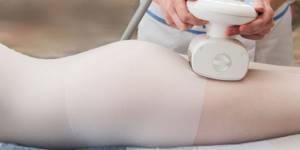
Course duration
One massage course includes 30 procedures performed daily. After their completion, it is recommended to take a break for 10-15 days. Nutritionists and doctors note that using self-massage for weight loss cannot lead to significant weight loss. An important part of the process of fighting excess fat is a healthy diet and regular exercise.
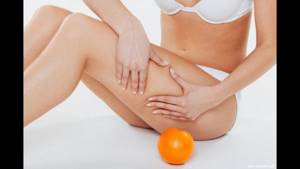
How to properly massage for slimming thighs
A course of self-massage of the thighs for weight loss should be at least 15 procedures. Carry out sessions every other day, alternating massage with contrast showers, wraps and masks. Tissues respond more readily to exposure during regular procedures. Choose a specific time for your session, but try not to massage before bed. Don't forget to remove rings and bracelets to avoid injury. To benefit from self-massage and not harm the body, you need to approach the procedure competently:
- Remember, no technique should be performed through pain. If you are in pain or bruising, you are doing something wrong.
- Perform all techniques from the bottom up, from the periphery to the center, watch your breathing - breathe deeply, calmly, through your nose.
- Before and after the session, take a warm shower.
- Apply massage oil or special cream to your hands.
- Place your leg bent at the knee on a low chair, armchair or bench, relax the leg being massaged by stroking it. Start at the ankle and work your way up to the thigh. Gradually move from light strokes to more intense ones.
- Start kneading. On the outer side of the thigh, gather a fold and knead it towards the inner side. Don't forget about massage oil.
- Perform a squeezing technique. Using your fingertips, work the entire surface of the thigh.
- Repeat all points on the second leg.
- Perform the next step while sitting in one of the suggested positions:
- Sit on a chair, place your feet together, spread your knees to the sides. Massage the inner thigh, start with warming up by stroking, then intense kneading and squeezing, soothe the skin with calm stroking. To massage the back of the thigh, move your leg to the side, lift your heel and repeat the techniques.
- Sit on the edge of the sofa so that you are comfortable. Place one leg along the sofa, place the other on the floor. In the upper part of the outer side of the thigh, perform a longitudinal kneading technique, then shaking, move towards the middle. Stretch your inner thigh. Perform patting and stroking in a circular motion.
- When using a combined massage, the next step is to work the thighs, according to the instructions of your device. Please note that the groin area and inner thighs cannot be affected by vacuum massage.
- Intensely rub your leg from ankle to thigh.
- End the session with stroking.
Auxiliary materials
Special means will help make the procedure more comfortable and enhance the effect of a hip self-massage session. The main auxiliary massage materials include: soap, powder, basic and essential massage oils, anti-cellulite creams, alcohol and emulsion preparations.
- Soap is the simplest means for self-massage in the bath or shower. A significant disadvantage of soap is that it will not ensure long-term sliding of hands over the body. If you decide to conduct a self-massage session in a bathhouse, perform the techniques after the steam room, in a room with a temperature of at least 25 degrees.
- Powder - used if there is a need to dry the skin, for example, with increased sweating, in order to avoid inflammatory processes.
- Massage oils - fatty or base oils improve the glide of hands over the skin; in combination with essential oils, they help more effectively fight cellulite, excess volume, and increase body elasticity. Depending on the choice of essential oil, they can have a warming, nourishing, moisturizing, toning or relaxing effect.
- Anti-cellulite creams also help improve gliding, increase the effectiveness of thigh massage for weight loss, moisturize and nourish the skin. Anti-cellulite cream can be purchased ready-made or made independently.
- Alcohol preparations are products used mainly for sports therapeutic massage.
- Emulsion preparations are presented on the market in four types: universal, warming, refreshing, eliminating pain and relieving fatigue. A warming emulsion preparation is suitable for tonic self-massage of the thighs.

Reviews
Tatyana N. – I would like to leave my review about anti-cellulite massage, I have been doing it periodically for several years. At first I went to the salon twice a year, but it was a bit expensive, now I massage myself at home - no worse, only my hands get tired. The effectiveness is the same, the main thing is not to be lazy and massage regularly, that’s all!
Olga S. – I heard that for massage they use a steamed bamboo broom and slap it on the butt and thighs. Interesting, I'll have to try it.
Inna P. – Like a bamboo broom, some resourceful young ladies massage their cellulite with an ordinary soap dish (the back side is usually ribbed). And others roll a rolling pin over their thighs and speak effectively.
Contraindications
Familiarize yourself with the procedure. Conduct the session carefully, follow the specified technique. Make sure there are no contraindications for self-massage. If in doubt, consult your doctor.
Massage for weight loss of legs and thighs is contraindicated for:
- pregnancy, in the first two months after birth;
- oncological diseases;
- hemophilia;
- heart failure;
- aneurysm of blood vessels, heart;
- varicose veins;
- active tuberculosis;
- mental illnesses.
Some contraindications are temporary; you can continue to perform procedures after proper treatment:
- increased body temperature;
- bleeding;
- purulent skin lesions;
- acute allergies;
- hypotonic, hypertensive crisis.
